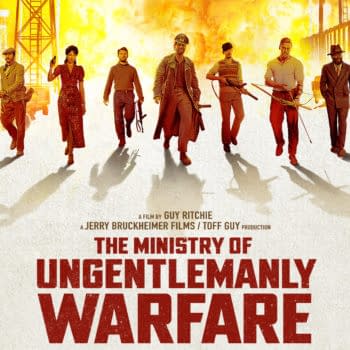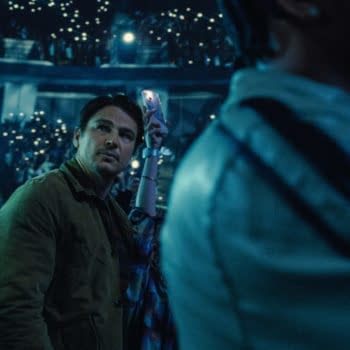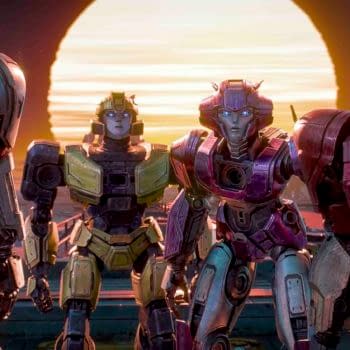Posted in: Movies, Video Games | Tagged: dungeons & dragons, dungeons and dragons, Kobold Press, rpg, RPG Gaming, Steve Winter, Tyranny of Dragons, wizards of the coast, Wolfgang Bauer, Wolfgang Baur
Talking D&D's Tyranny Of Dragons With Wolfgang Baur And Steve Winter
By Christopher Helton
Back when information starting trickling in from the official sources about the new edition of Dungeons & Dragons, one of the first things that we discovered was that the early adventures would be written by Wolfgang Baur and Steve Winter of Kobold Press, and published by Wizards of the Coast as part of the official D&D game line. I was able to talk with Baur and Winter about their backgrounds and the upcoming adventures.
For those readers who might not be as familiar with your backgrounds in gaming, Wolfgang, you've worked as a designer and editor at TSR and Wizards of the Coast, and the old Iron Crown Enterprises, before striking out on your own with Kobold Press. Steve, you landed a job at TSR in 1981, and worked as an editor, developer, designer, fiction author, creative director for AD&D, and managing editor of Dragon and Dungeon magazines.

Wolfgang Baur: I learned the ropes in the magazines, which meant that I was always under a deadline and always looking ahead to the next project. Meeting deadlines was compulsory for magazines; if you missed them, you just screwed yourself for the following issue. So I learned some good habits that way. In addition, I learned editing from three exceptionally talented people, Kim Mohan, whose work includes a great deal of D&D's foundations from the 70s until his recent retirement, Barbara Young (of Dungeon Magazine) and Roger Moore (an excellent editor of Dragon).
I thought that prepared me for working as a publisher. I was mostly wrong about that, and wish I'd spent some time on accounting and business classes in college. Boring, but true.
CH: You've become known for your setting development, starting with the City of Zobeck and expanding that into the world of Midgard. How important is your play to the development cycle of your works like these?
WB: For Zobeck, play was the thing that drove development. People wanted to run scenarios in a gritty town, and so they got one. I wanted an odd little kobold ghetto, a place sealed off from human eyes, so it has that. Most of Zobeck is very organically grown from play.
Midgard is more of a mix, as some sections have seen a lot of play (the Crossroads around Zobeck, but also the Seven Cities and the Wasted West and the magocracies). Others have seen less than I would like (like Dornig and the North), but I tend to think that daydreaming and worldbuilding can go hand-in-hand sometimes. Play is really useful for turbocharging your worldbuilding; but you know, J.R.R. Tolkien and others did fine worldbuilding without ever rolling a d20. So there's that.
CH: How much of an impact upon the design of a setting does the rules have? Do you find yourself needing to bend or adapt material to better fit into different systems?
WB: Rules definitely matter, but less than you might think sometimes. The monster challenge levels are the main thing, but factors like healing rates and default classes matter too. When you jump to 13th Age from, say, D&D 3.5, you are saying things about the level of high magic and the importance of certain NPCs, like the Midgard icons. In my experience, an experienced game master with veteran players can adapt to these sorts of changes just fine. Players who have a high degree of interest in a single system (like the 3.5/Pathfinder d20 engine) tend to have little interest in branching out, but I find those cross-system jaunts energizing and fun. Heck, I loved the Thieves World RPG boxed set from Chaosium in the late 80's exactly because it had stats for the same characters in many different systems.
It's very doable from a design perspective. The more common limitation tends to be whether players want to explore new mechanics.

CH: Now for the new edition of D&D you are getting to design the first published adventures. Do you feel any pressure that you may be responsible for what many new and old players consider to be the tone of the new edition, because of your adventures?
WB: It's definitely a big responsibility, and there's a lot of requirements and goals for an early adventure like this. Partly, you're teaching a new generation how the game works for this generation, and you're teaching the existing players what is new about the approach of the new edition of D&D.
SW: At the same time, we don't want to give the idea that Tyranny of Dragons [ToD] represents THE WAY to play this new edition of D&D. ToD is a far-reaching adventure that encompasses quite a few different styles, but it's not exhaustive. The new edition is tremendously well suited to handling a multitude of playing styles. As proud as I am of Tyranny of Dragons, the last thing I'd want to see is every adventure that follows it mimicking the same pattern.
CH: What can you tell us about what these adventures (Hoard of the Dragon Queen and The Rise of Tiamat)? What are their elevator pitches going to be (as much as you are allowed to say)?
WB: Hoard of the Dragon Queen is about the Cult of the Dragon deciding that it's time to really prove just how superior their draconic masters are, by taking over a good chunk of the Realms. They have a glorious plan to seize the Tri-State Area, as it were, but they are—as cultists so often are—a little less terrifying when it comes down to the level of their footsoldiers and minions. The PCs get a chance to learn exactly why the game is called Dungeons & Dragons—and if the playtesters can be believed, there's some real moments of terror in this adventure.
And we've just made the Hoard autographed edition available for preorder, only at the Kobold Store!
SW: The elevator pitch for The Rise of Tiamat is that the Cult of the Dragon is all prepped to usher Tiamat back to Faerủn and set her up as the queen of everything. And by "all set," we mean that if someone doesn't stop them, they'll do it. When The Rise of Tiamat kicks off, the Cult is poised at the edge of victory. Characters need to take risks and be aggressive to prevent something awful from happening. There's real potential for catastrophe in this adventure. Even if the characters win, the Cult's raids will have caused enormous upheaval along the Sword Coast.
CH: With as much as you can say, what for you was the most interesting aspect of designing an adventure for the new edition?
WB: For me, it was getting to create a particular dragon lair that I won't spoil. And really, it was interesting to have villains with a little more ambition AND an army of evil, scaly, fire-breathing death machines to back it up. Maybe I've designed a few too many demons and undead adventures, but it felt great to get draconic. Evil takes to the sky, and sets fire to a few towns—that's classic motivation for any decent group of players.
CH: As a gamer, what has you excited about the new edition of D&D?
SW: I've said this elsewhere, but there's a feeling of coming home about this new edition. Everyone has their favorite edition of D&D, and for decades, mine has been the 1981 Basic/Expert edition–the one with the crazy Erol Otus paintings on the covers. This new edition recaptures a lot of what made that early experience so great. At the top of the list is that it's easy to run and it plays fast. This new D&D gives players and DMs plenty to think about, but doesn't overload anyone with minutiae.
WB: I think players may have had it a little too easy the last couple editions; this edition introduces a bit more risk. Players, you will want to think carefully before you kick down the door. I like that sense of…not fear exactly, but caution, that you get when players know that not everything is perfectly balanced and perfectly easy to defeat.
CH: As a designer, and as a gamer, what elements are important to the design of an enjoyable adventure?
WB: Exotic locations of high magic, interesting villains with deadly powers, and mostly—some treasures beyond just gold. DMs and designers tend to forget this, but cool treasures are really memorable, important moments for players. I have one magic item that got cut that makes me a little sorry to see it go. I will probably put it back in the treasure pile when I run my own modded version.
SW: I'm a lot stingier with treasure than Wolf is. I love it as a player, of course, but as a DM, I find picking out treasure a little boring. It's a bit too much like shopping for paint. I tend to think a lot about pacing, as a DM and as a designer. A good adventure has episodes of high tension, puzzlement, a few slow stretches to lull players into complacency, and moments of mortal terror. It can't just be a constant glide path to victory or there'll be no emotional highs and lows. Drama requires ups and downs, victories and setbacks. I like to ensure players get a bit of a roller-coaster ride during the adventure.
Christopher Helton is a blogger, podcaster and tabletop RPG publisher who talks about games and other forms of geekery at the long-running Dorkland! blog. He is also the co-publisher at the ENnie Award winning Battlefield Press, Inc. You can find him on Twitter at @dorkland and on G+ at https://plus.google.com/+ChristopherHelton/ where he will talk your ear off about gaming and comics.
Christopher has a crowdfunding page to help raise money to defray the costs for going to the Gen Con gaming convention and cover it for his Dorkland! blog and Bleeding Cool. Please click here to go to the page and help out.


















